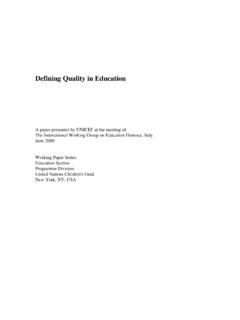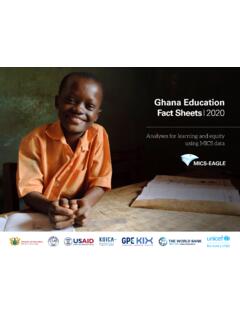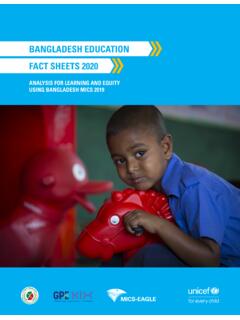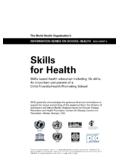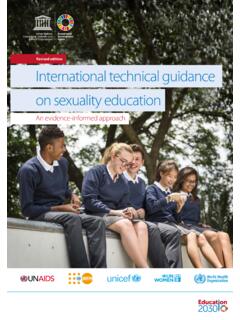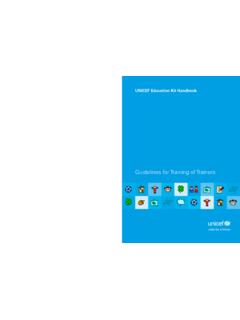Transcription of Child Rights Education Toolkit - UNICEF
1 Unite for childrenChild Rights Education Toolkit :Rooting Child Rights in Early Childhood Education , Primary and Secondary SchoolsFirst Edition 2014 All Rights publication may be reproduced, as a whole or in part, provided that acknowledgement of the source is made. Notifi cation of such would be by: UNICEF Private Fundraising and Partnerships Division (PFP)Geneva, 2014 This fi rst edition of the Child Rights Education Toolkit is a provisional release prepared with a focus on experiences in countries with a UNICEF National Committee presence. It is important to note, however, that the principles and approaches contained in the Toolkit are applicable for all countries. We encourage both National Committee and UNICEF country offi ce colleagues to pilot the Toolkit and to apply its exercises and tools.
2 We kindly request that you send any feedback or suggestions to the Child Rights Advocacy and Education Unit, Private Fundraising and Partnerships Division: and Your inputs will inform the development of a second and fi nal edition of the - A guide for UNICEF National Committees - 1st EditionChild Rights Education Toolkit :Rooting Child Rights in Early Childhood Education , Primary and Secondary SchoolsFirst Edition4 - Child Rights Education Toolkit : Rooting Child Rights in Early Childhood Education , Primary and Secondary SchoolsChapter 1 How to use this ToolkitChapter 2 Understanding Child Rights educationChapter 3 Introducing the CRE Tree Chapter 4 Whole school approachChapter 5 Learning as a rightChapter 6 Learning about rightsChapter 7 Learning through rightsChapter 8 Learning for rightsChapter 10 Programme cycle managementGlossaryChapter 9 Foundations and sustainabilityUNICEF Child Rights Education Toolkit - 1st Edition - 5 CHAPTER 1 Toolkit structure at a glanceCEUNICPPTER 1 CCSEEDI ntroduction Chapter 1 provides background on the Toolkit .
3 Chapter 2 clarifi es what is meant by CRE ; situates CRE in school settings in the context of CRE in other settings and in UNICEF s work. Chapter 3 introduces the metaphor of the CRE Tree; situates CRE work at the school level within the context of broader educational reform; out-lines the role of advocacy and capacity of CRE initiativesUsing the CRE Tree, the following chapters provide an overview of types of initiatives: Chapter 4: whole school approach (centre of tree) Chapter 5: learning as a right (tree trunk) Chapter 6: learning about Rights (branch) Chapter 7: learning through Rights (branch) Chapter 8: learning for Rights (branch)These chapters emphasize the importance of systematic and logical connections between these and sustainability for CRE initiatives Chapter 9 emphasises the need for CRE initiatives to be properly rooted in certain key principles.
4 Provides a framework for assessing the CRE Tree s growing conditions . Programme cycle management for CRE initiatives Chapter 10 outlines four stages from seed to tree : situation analysis/needs assessment; planning; implementation and monitoring; Provides explanations of key terms. Appendices are available as a separate document, providing additional tools, resources and - Child Rights Education Toolkit : Rooting Child Rights in Early Childhood Education , Primary and Secondary SchoolsForewordThe Child Rights Education concept speaks to UNICEF s global Child Rights mandate and should be embedded in our global approach to advocacy. It provides space to engage constructively with children on the realization of Rights globally, with emphasis on inequities and the situation of marginalized children in both the developing and the industrialized Rights Education should be understood in a broad sense, far beyond the subject of a lesson plan.
5 It entails teaching and learning about the provisions and principles of the Convention on the Rights of the Child (CRC) as well as the Child Rights approach to help empower both children and adults to take action and put children s Rights into practice in their day-to-day lives at home, at school, in the community and, more broadly, at the national and global levels. Child Rights Education is learning about Rights , learning through Rights (using Rights as an organizing principle to transform the culture of learning) and learning for Rights (taking action to realize Rights ). Child Rights Education promotes the vision articulated in the CRC Preamble that the Child should be fully prepared to live an individual life in society, and brought up in the spirit of the ideals proclaimed in the Charter of the United Nations, and in particular in the spirit of peace, dignity, tolerance, freedom, equality and solidarity.
6 Child Rights Education is seen as an essential tool for changing how children s Rights are perceived and applied in society. It aims to build the capacity of Rights -holders, especially children, to claim their Rights and the capacity of duty-bearers to fulfi l their obligations. It helps adults and children work together, providing the space and encouragement for meaningful participation and sustained civic engagement. It is therefore with very great pleasure that I welcome the publication of this ambitious, comprehensive yet practical Child Rights Education Toolkit . The Toolkit is the result of an exciting collaboration between UNICEF s Private Fundraising and Partnerships Division in Geneva and key personnel from UNICEF s Programme Division in New York. This fi rst edition has benefi ted from multiple consultations with National Committee colleagues and other United Nations and academic experts.
7 Although this Toolkit focuses on Child Rights Education in the formal learning environment (early childhood Education settings, primary and secondary schools), it is hoped that it will also be useful for those working to promote Child Rights Education through other channels, such as in the media, with children s organizations and through children s involvement in Toolkit supports efforts to achieve the Education outcomes of the UNICEF Strategic Plan 2014 2017 and will contribute signifi cantly to achieving the goals of the UNICEF Private Fundraising and Partnerships Plan 2014 join me in promoting Child Rights Education as an essential pathway leading to the respect, protection and fulfi lment of all children s Rights Pakkala, Director, Private Fundraising and PartnershipsThe fi rst edition of this Toolkit includes quotations and project examples particularly relevant to work undertaken by UNICEF National Committees.
8 The second edition will also include material more relevant to UNICEF country offi ces. The principles and approaches to Child Rights Education , however, are the same for all UNICEF offi ces, regardless of Child Rights Education Toolkit - 1st Edition - 7 AcknowledgementsThe idea for this Toolkit originated in discussions between the UNICEF National Committee Child Rights Education Think Tank (formerly known as the Education for Development TaskForce ) and the Child Rights Advocacy and Education section of UNICEF s Private Fundraising and Partnerships Division based in Geneva. Initially intended to support the Education for Development work of UNICEF National Committees, over a period of time this Toolkit expanded to embrace a vision of Child Rights Education relevant for the whole of UNICEF project was led by the Child Rights Advocacy and Education section and the Toolkit main drafter.
9 It was guided by the Toolkit Steering Group and the Child Rights Education ThinkTank. Staff from UNICEF National Committees provided input and feedback on drafts, and helped to pilot the tools during a series of Child Rights Education workshops in London,Belgrade and Geneva from November 2011 to April 2013. Additional expertise was provided by UNESCO, OHCHR, Amnesty International, Queen s University Belfast, St Patrick s College Dublin and individual main drafter, Marie Wernham, would like to thank the following individuals for their invaluable guidance, provision of materials, input into questionnaires and feedback on multiple drafts of the Toolkit , and for their infi nite enthusiasm, support and Private Fundraising and Partnerships: Beate Baglietto, Elke Holderbeke, Jyothi Kanics, Jens Matthes, Alison Rhodes, Frederike Seidel and James Elrington (design and layout) UNICEF Child Rights Education Toolkit Steering Group.
10 Zayn Abaakil, Nicola Brandt, Paula Claycomb, Anne Daher Aden, Clarice Da Silva e Paula, Myriam Dems, David Donaldson, Paula Gallo, Stephanie Hodge, Jens Matthes, Andrew Mawson, Gopal Mitra, Nicolette Moodie, Morgan Strecker, Nurper Ulkuer, Marie Wernham (consultant) UNICEF National Committee Child Rights Education Think Tank (past and present): David Donaldson, Lisa Ericson, Paula Gallo, Anne-Mette Friis, Walter Hesselink, Kyung-Hee Kim, Scott Hirschfeld, Maja Planinc, Carole Reminny, Ellen Sand eUNICEF National Committees: Francisca Baptista da Silva, Oscar Belmonte Castell, Frances Bestley, Alice Bottini-Hall, Kitty Chan, Lesley Chau, Manuela D alessandro, Alexandra Drakov , Szilvi Gyurk , Monique Hughes, Jin-ha Kim, Marie-Armelle Larroche, Amaya L pez de Turiso S nchez, Carissa MacLennan, Rania Makri, Marianne Mueller-Antoine, Enrico Noviello, Quima Oliver Ricart, Alja Otavnik, Ari Paloniemi, Malgorzata Polowniak, Pascale Recht, Alexander Schwentner, Sebastian Sedlmayr, Jacqui Southey, Lisa WolffUNESCO: Massimo Amadio, Dakmara GeorgescuOHCHR: Petra TichaOthers: Jean Zermatten (Committee on the Rights of the Child ); Aurelia Donnard (Amnesty International); Laura Lundy and Lee Jerome (Centre for Children s Rights , Queen s University Belfast).










